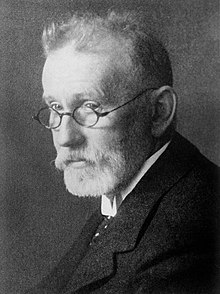পাউল এরলিখ: সংশোধিত সংস্করণের মধ্যে পার্থক্য
Saifulislam09 (আলোচনা | অবদান) নতুন নিবন্ধ কাজ চলছে ট্যাগ: মোবাইল সম্পাদনা মোবাইল ওয়েব সম্পাদনা |
(কোনও পার্থক্য নেই)
|
১৪:৩৩, ১ জুলাই ২০১৯ তারিখে সংশোধিত সংস্করণ
এই নিবন্ধ বা অনুচ্ছেদটি পরিবর্ধন বা বড় কোনো পুনর্গঠনের মধ্যে রয়েছে। এটির উন্নয়নের জন্য আপনার যে কোনো প্রকার সহায়তাকে স্বাগত জানানো হচ্ছে। যদি এই নিবন্ধ বা অনুচ্ছেদটি কয়েকদিনের জন্য সম্পাদনা করা না হয়, তাহলে অনুগ্রহপূর্বক এই টেমপ্লেটটি সরিয়ে ফেলুন। ৪ বছর আগে Saifulislam09 (আলাপ | অবদান) এই নিবন্ধটি সর্বশেষ সম্পাদনা করেছেন। (হালনাগাদ) |
Paul Ehrlich (জার্মান: [ˈpaʊ̯l ˈeːɐ̯lɪç] (ⓘ); 14 March 1854 – 20 August 1915) was a Nobel prize-winning German-Jewish physician and scientist who worked in the fields of hematology, immunology, and antimicrobial chemotherapy. He is credited with finding a cure for syphilis in 1909. He invented the precursor technique to Gram staining bacteria. The methods he developed for staining tissue made it possible to distinguish between different types of blood cells, which led to the capability to diagnose numerous blood diseases.
পল এরলিস | |
|---|---|
 | |
| জন্ম | ১৪ মার্চ ১৮৫৪ |
| মৃত্যু | ২০ আগস্ট ১৯১৫ (বয়স ৬১) |
| নাগরিকত্ব | জার্মান |
| পরিচিতির কারণ | কেমোথেরাপি, রোগ-প্রতিরোধ বিদ্যা |
| দাম্পত্য সঙ্গী | Hedwig Pinkus (1864–1948) (m. 1883; 2 children) |
| সন্তান | Stephanie and Marianne |
| পুরস্কার | Nobel Prize in Physiology or Medicine (1908) |
| বৈজ্ঞানিক কর্মজীবন | |
| কর্মক্ষেত্র | রোগ-প্রতিরোধ বিদ্যা |
| উল্লেখযোগ্য শিক্ষার্থী | হ্যান্স্লসবার্গার |
| স্বাক্ষর | |
 | |
His laboratory discovered arsphenamine (Salvarsan), the first effective medicinal treatment for syphilis, thereby initiating and also naming the concept of chemotherapy. Ehrlich popularized the concept of a magic bullet. He also made a decisive contribution to the development of an antiserum to combat diphtheria and conceived a method for standardizing therapeutic serums.[১]
In 1908, he received the Nobel Prize in Physiology or Medicine for his contributions to immunology.[২] He was the founder and first director of what is now known as the Paul Ehrlich Institute.
- ↑ "Paul Ehrlich"। Science History Institute। জুন ২০১৬। সংগ্রহের তারিখ ২০ মার্চ ২০১৮।
- ↑ The Nobel Prize in Physiology or Medicine 1908, Paul Erlich - Biography